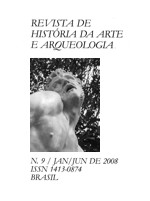Abstract
This article discusses prescriptive and encomiastic aspects of the role of ecphrasis as a discursive topic in treatises on painting in the first half of the XVI century, specifically the work Da Pintura Antiga, by the Portuguese painter Francisco de Holanda. We wish to examine not only the mechanisms by which the treatises of the period went about transferring from classical rhetoric the pictorial qualities of the discourse to the scope of the craft of painting, but also the modus by which this imitative topic operates in conjunction with other old epideictic topics such as ut pictura poesis, chria, as well as modern rhetorical topics
such as Rinascita of the arts and the Paragone between painting and sculpture.
References
ANDERSON. The Second Sophistic: a cultural phenomemom in the Roman Empire. London: Routledge, 1933.
ALBERTI. Da Pintura. Tradução de Antonio da Silveira Mendonça. Campinas: Editora da Unicamp, 1992.
BALDWIN, Charles S. Medieval Rhetoric and Poetic, New York: The MacMillan Company, 1928.
BAXANDALL, Michael. Giotto and Orators. Humanist observes of painting in Italy and the Discovery of pictural composition, 1350-1450. Oxford: Oxford University Press, 1971.
BIAGINI, Enza. “Ecfrasi, Dipintura. Sguardo sulle teorie della descrizione nei trattati del Cinquecento”. In: VENTURI, Gianni; FARNETTI, Monica. Ecfrasi. Modelli ed esempi fra medievo e rinascimento, Roma: Bulzoni, 2004, t. II.
BOCCACCIO. Il Decameron. Milano: Mursia, 1966, VI.
BOCCACCIO. Il Comento alla Divina Commedia. Bari: Ed. D. Guerri, 1918.
CICERO. Orator. Cambridge: Harvard University Press, 1988.
CICERO. De Partitione Oratoria. Cambridge: Harvard University Press, 1997.
FILOSTRATO, O VELHO. Imagines. Cambridge-London: Harvard University Press, 1979, I, 294 K-295K, 1-29.
GAURICO. Sobre la escultura (1506), comentado y anotado por André Chastel y Robert Klein, Madrid: Akal, 1996.
HERMOGENES. L’Art Réthorique. Paris: L’ Age d’Homme pour la préface et l’introduction et Les Belles Lettres pour la traduction française, 1997, Progymnasmata.
HOLANDA, Francisco de. Da Pintura Antiga. Introdução e notas de Angel González Garcia, Lisboa: Imprensa Nacional-Casa da Moeda, 1983.
MURPHY, James J. La Retórica en la edad Media: historia de la teoría de la retórica desde San Agustín hasta en Renacimiento. México: Fondo de Cultura Económico, 1986.
PATRIZI, Giorgio. “Le ragioni dell’ecfrasi. Origini e significato della narrazioni vasariane”. In: VENTURI, Gianni; FARNETTI, Mónica.
PLINIO. Naturalis Historia. Paris: Belles Lettres, 1997, XXXV.
QUINTILIANO. Instituto Oratoria. Cambridge: Harvard University Press.
VARCHI, Benedetto. Della maggioranza delle arti (1547). In: BAROCCHI, Paola. Scritti d’Arte Del Cinquecento. Milano: Riccardo Ricciardi, 1971.
VASARI, Giorgio. Le Vite. Roma: Newton Tascabili, 1993, “Vita di Giotto”, I.
VASARI, Giorgio. “Introduzione alle tre arti del disegno”, cap. XV. Della Pittura.
VICKERS. “Epideictic and Epic in the Renaissance”. In: MURPHY, James J. Renaissance Eloquence: studies in the Theory and Practice of Renaissance Rhetoric. Berkeley: University of California Press, 1983.
VILLANI. De origine civitatis Florentie, et de eiusdem famosis civibus, Biblioteca Vaticana, MS, Barb.lat, 2610, fols. 71r-72r.
WEINBERG, Bernard. A history of literary criticism in Italian Renaissance, vol. II. Chicago: University of Chicago Press, 1961.

This work is licensed under a Creative Commons Attribution 4.0 International License.
Copyright (c) 2021 Journal of Art History and Culture

